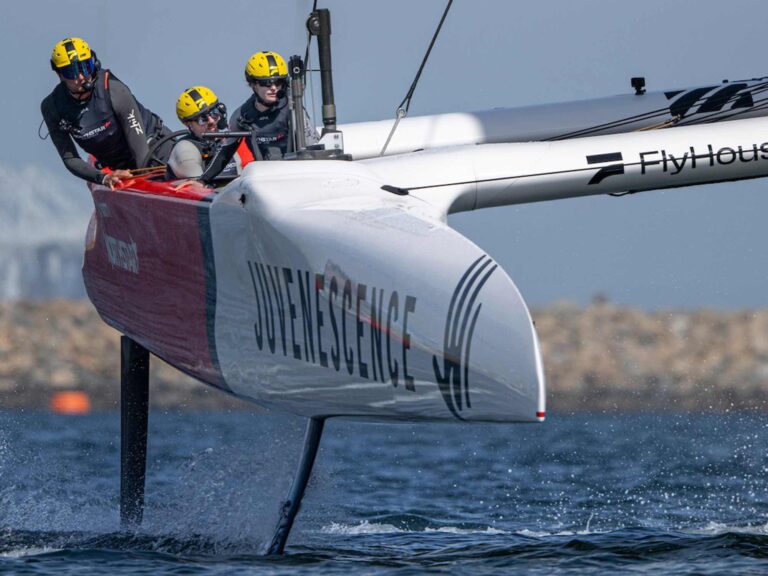“I see said the blind man as he picked up his hammer and saw.”
It’s a simple little wordplay I often say to my kids, even though they never really “get it.”
I thought of this on Wednesday morning as I listened to Ensign national champion Vince Morvillo as he carefully paced the stage while speaking to an attentive audience at Sail America’s Industry Conference in Annapolis, Md. Morvillo, a blind sailor and highly successful yacht broker from Texas (Sea Lake Yacht Sales), was enlightening the sailing industry’s biggest shakers about how he and his sales team had pulled out new tools from their yacht-hawker’s tool box to deal with the financial meltdown that has been the past several years.
“Embrace change,” he told the crowd. “Change is a gift.”
Part inspirational, part well-heeled advice, Morvillo’s task for the next 40 minutes or so was to rattle the industry out of its complacency and into action. His advice was all elementary stuff—get creative, make it all about the customer, tack on the headers sort of logic—but it carried weight. For Morvillo came to his success by walking the walk, and here was proof that the blind man had clearly picked up his hammer and cut to the chase: the sailing industry needs to re-think how it conducts its business. To paraphrase Morvillo and many other speakers that followed: for the good of the sport of sailing, it’s time the industry changes tack and pays attention to not only its products and services, but how we attract—and more importantly, how we retain—more sailors (the lack of bank financing aside). In my fifteen years in the industry, I’ve heard this call to action more than once. And so the call goes out to the choir once again: the sport is only as good as the industry that serves it.
Morvillo was supported by a cast of many others: the U.S. Sailing Team’s Dean Brenner (whose other job is an executive coach and motivational speaker) espousing how to motivate and manage one’s team (employees) through saying (and doing) the “right” thing; Gary Jobson on the barriers hamstringing the sport and the opportunities ripe for development; and others covering topics of social media usage for business, internet practices, and sustainable (“green”) development. While the topics varied, each speaker eventually hit on that one relevant and repeatable call to action: nurture the business and the sailors we have and coddle the younger ones arriving into the sport at a statistically impressive rate.
Most interestingly (to me at least), Neal Schwartz, of the National Sporting Goods Association (“the numbers guy”), had statistics that cast a ray of golden sunlight from behind the dark cloud of the past year. The NSGA tracks participation trends for every sport imaginable, and the sailing numbers were positive. The long-term forecasts were even better. By 2012, says Schwartz, the sport will enjoy “a kiss” (which will have some tie to the growing wealth divide in this country). The line chart creeped progressively upward, but there was a caveat: there will be plenty of new sailors coming in, but plenty more going out. In other words, sailing still has its retention problem (which he calls the “leaky bucket,” but a more apt description might be the “leaky boat.”) According to the NSGA’s numbers, we’ll be better off than football and golf, which are headed downhill quickly. One other non-surprise was the high number of “acquisitions” at the youth level—in particular young girls; both groups, Schwartz noted, should be prime targets for the industry as it looks to ensure its vitality.
The NSGA survey also delved deeper into the habits of sailors as consumers, specifically where and how they’d spend their money on sailing. One interesting question on the survey dealt with club membership; most respondents said they would maintain their club membership. As I thought about this one statistic, another recent and relevant study came to mind, this one being the 2010 yacht club survey conducted by the Gowrie Group (the resultant report is titled: “16 Best Practices for Energizing Your Club & Sailing Programs, and the PDF is downloadable here) One of their findings was that 74 percent of clubs (100 clubs polled) felt “too few teenagers were participating in sailing at their club.” Another problem was attracting the 25- to 35-year-old sailors. The study is loaded with good ideas, so it’s definitely worth a look. I’m probably preaching to the choir here, but as the attendees at this year’s Industry Conference will attest, the sport won’t grow on its own; we all need to take it forward. For better clarity on how to do so, we all need to pick up our hammers see.









